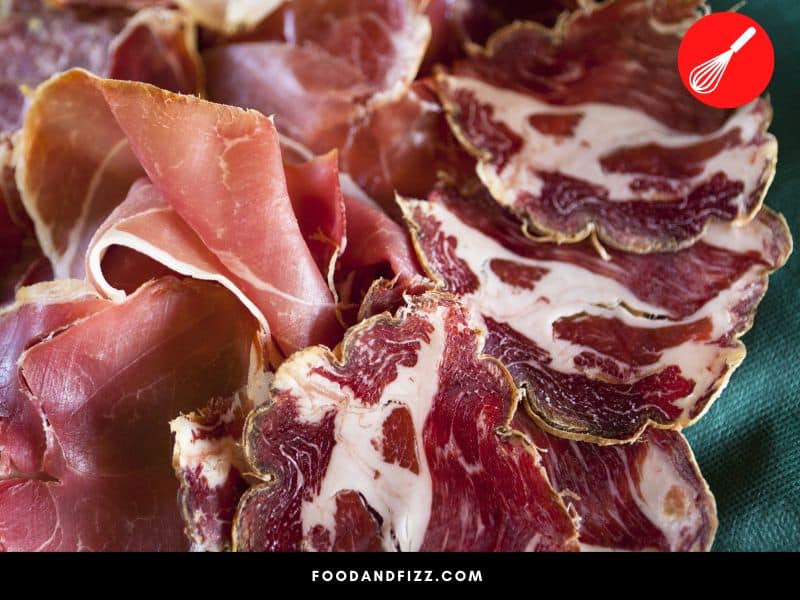Curing meat is one of the oldest and most effective ways of food preservation, with many cultures retaining their rich tradition of curing and fermenting up to this day.
Cured meats are delicious, but they also raise some legitimate health concerns. Cured meats are typically cured and processed with chemical and synthetic salts, which have been linked to certain illnesses like cancer.
Because of this, there is an understandable clamor for a healthier choice, and some can understandably think that if curing is the culprit, certainly “uncured” is the best way to go?
For example, when faced with the choice between cured pepperoni or uncured pepperoni, some believe that uncured pepperoni would not offer the same health risks as traditionally cured pepperoni.
But is this really the case? What exactly is uncured pepperoni and how might it be different from cured pepperoni?
What Is Uncured Pepperoni?
Uncured pepperoni is pepperoni that has been cured and preserved using salt and natural curing agents and preservatives derived from natural sources like celery and beets. Despite the label, it is still a cured product that goes through the same curing and fermentation process as traditionally cured pepperoni.

Uncured Pepperoni – What Is It All About?
Uncured pepperoni is actually a bit of a misnomer since it is not uncured per se. It is still a cured product that goes through pretty much the same process of curing, fermenting, and drying.
It is just not cured using the usual curing agents and salts. Uncured pepperoni, rather, is cured using natural preservatives and nitrates that are naturally found in celery or beets.
It is also preserved using only natural preservatives like salt, as opposed to artificial preservatives commonly added to regular cured meat.

Natural vs Synthetic Curing Agents
Regular pepperoni is cured with the addition of curing salts, also sometimes called “pink salt” (not the same as Himalayan pink salt, though!).
These contain sodium nitrates and nitrites that protect the meat from bacterial spoilage and act as a preservative. They also protect the meat from the pathogen that causes botulism.
These nitrates and nitrites are also what give cured meats their characteristic pink and reddish hue, due to the interaction of the nitrates and nitrites with the myoglobin in the meat.
Uncured pepperoni, on the other hand, is cured with salt and with ingredients that have naturally-occurring nitrates and nitrites in them, like celery and beets.
Usually, these natural curing agents are in juice or powder form, and added to the meat mixture prior to stuffing, fermenting and drying.
Nitrates and their broken-down form, nitrites, are actually naturally found in soil, water, and air. Vegetables, especially green leafy vegetables and root crops, would inevitably contain nitrates and nitrites in varying degrees.
Celery and beets are among those with significant amounts and are the ones most commonly used in “uncured” meats.
The nitrates naturally found in celery and beets, when treated with bacterial cultures that break down the nitrates into nitrites, along with salt, are the agents that cure and preserve the uncured pepperoni.
Thus, the resulting product would still contain controversial nitrates and nitrites, albeit from different sources.

“Uncured” Label
In the past, USDA regulations actually required for cured meat to be labeled “uncured” if it does not use or contain any of the known synthetic, chemical curing nitrates and nitrites.
If meat is cured using celery or beet powder, the label “uncured” must be put on the label, along with the phrase “no nitrates or nitrite added”.
This has caused confusion in the industry and has led many to believe that uncured meats are healthier and contain no nitrates and nitrites at all, which isn’t the case.
Some groups have petitioned to change this labeling regulation on the grounds that it can be misleading to consumers, since both products cured with synthetic chemicals and natural preservatives have been found to contain the same amount of nitrates and nitrites, and thus, would pose the same health risk.
The USDA partially granted this request in 2020 in order to improve labeling regulations.
What Is the Difference Between Uncured Pepperoni and Cured Pepperoni?
Uncured pepperoni and cured pepperoni are typically made with the same ingredients and would be very similar to each other, however, they have notable differences.
We’ll look at some of those below.
1. Curing Agents
As we already said, uncured pepperoni is cured using celery or beet juice or powder, inoculated with bacterial cultures to break down the naturally occurring nitrates into the nitrites that will cure and preserve the meat.
Cured pepperoni on the other hand, uses pink salt and other artificial preservatives to cure and preserve the pepperoni.
2. Salt Content and Taste
As uncured pepperoni would not have artificial preservatives and relies on natural ingredients to prevent spoilage, it may contain more salt compared to its cured counterparts.
Salt is a natural preservative and naturally prevents bacteria from proliferating in the meat. Uncured pepperoni, due to the absence of other types of preservatives, may compensate for this fact by using more salt in the product. This may possibly make uncured pepperoni saltier than cured pepperoni.
3. Color Of The Pepperoni
Uncured pepperoni may have a paler color than its cured counterpart, owing to the difference in curing agent or preservative used.
They may not look exactly like the bright red pepperoni cured using artificial curing agents like sodium nitrate and sodium nitrite.
4. Shelf Life
Because it does not have artificial preservatives, uncured pepperoni may have a shorter shelf life than the cured variety.
Read also: Uncured Pepperoni Vs Cured -The Important Difference!
Is Uncured Pepperoni Safe to Eat?
Like regular pepperoni, uncured pepperoni is also a cured, fermented and dried product, which means that it is safe to eat as long as it was processed, handled, and stored properly.
Bacteria and pathogens that cause illnesses can infiltrate meat at any stage of the manufacturing process, which is why it is important that we always get our cured meat from reputable sources who know what they are doing and who follow strict food safety protocols.
Is Uncured Pepperoni Healthier Than Cured Pepperoni?
Uncured pepperoni is made in the same way as cured pepperoni. The only major difference is that it is cured using natural nitrates and nitrites and uses only natural preservatives.
If by “healthier” we mean that it only contains natural ingredients and does not contain artificial chemicals, then uncured pepperoni can be considered healthier than cured pepperoni.
However, if we mean healthier in the sense that it has less nitrates or nitrites, then we cannot say that it is healthier since both cured and uncured pepperoni will contain roughly about the same amount of nitrates and nitrites. It’s just that the source of those nitrates and nitrites are different.
What’s the Deal with Nitrates and Nitrites?
Nitrates and nitrites in cured meat have been the subject of controversy, especially in health circles, for a long, long time.
When exposed to high heat, chemical reactions take place between nitrates and nitrites and the proteins and amino acids present in meat that convert these nitrates and nitrites into nitrosamines, which are known carcinogens.

Eating processed meat that contains nitrates and nitrites, then, increases exposure to these nitrosamines, and increases the risk of certain cancers.
Both cured and uncured pepperoni contain nitrates and nitrites which can turn into nitrosamine, so in terms of exposure to potential carcinogens, uncured pepperoni is not better than cured pepperoni.
The risk would seemingly be the same for both, as the source of these nitrates and nitrites would not matter when talking about a chemical reaction.
Given this then, it seems that both cured and uncured pepperoni would offer the same health risk, and the healthier and safer approach would be to exercise moderation in the consumption of either type of meat.
How To Use Uncured Pepperoni
Uncured pepperoni may be used in the same way as cured pepperoni, but you may have to adjust your seasonings as uncured pepperoni tends to be saltier than the regular, cured variety.
Taste your dish and adjust accordingly to ensure that you do not end up with something that is too salty.
Some uses for uncured pepperoni include:
- Topping for pizza
- Served on a cheese board
- Added to pasta
- Stuffed into mushrooms
- Tossed in a salad
- Sliced thinly, baked or fried, and made into pepperoni chips
- Minced and added burgers
- Sliced and added to sandwiches
- Topping for meatloaf
- Added as fillings to omelets
There are many other ways to use pepperoni in recipes. More recipe ideas may be found here.

How To Store Uncured Pepperoni
Pepperoni, when stored properly, can last a really long time. Unopened packages usually last a couple of weeks in a cool, dry place in the pantry. Once opened, they must be refrigerated and are best consumed within 3 weeks. They can also be stored in the freezer. Read about Can You Freeze Salami?
Specific storage instructions can usually be found on the package of your uncured pepperoni, and making note of these instructions will not only allow you to hold on to your pepperoni for a long time, but will also ensure that you are keeping it at its best quality.
Frequently Asked Questions To What is Uncured Pepperoni?
Where Can I Buy Uncured Pepperoni?
Uncured pepperoni can be sometimes be found in regular stores but are mostly found in specialty stores and natural food grocers, as well as online. With the rise in interest in natural foods, sources for uncured pepperoni are becoming more numerous, and it is becoming easier to find it in regular stores, too.
What is Pepperoni Made Of?
Pepperoni is a dry cured and fermented pork or pork and beef sausage. There are all-beef variations as well as chicken or turkey variations, but they have to be labeled as such. Pepperoni typically pertains to the all-pork or pork and beef mix.
What Is The Difference Between Uncured Pepperoni and Cured Pepperoni?
Uncured pepperoni and cured pepperoni differs mainly in what is used to cure them. Uncured pepperoni uses naturally derived curing agents while cured pepperoni uses synthetic curing salts.
Conclusion to What is Uncured Pepperoni?
Uncured pepperoni is pepperoni that has been cured using curing ingredients that are derived naturally and does not contain any artificial preservatives.
Curing agents derived from celery or beets are usually used as opposed to synthetic curing agents like pink salt. However, the ingredients and process are mostly the same.
Both cured and uncured pepperoni contains nitrates and nitrites, and one is not significantly healthier than the other.

